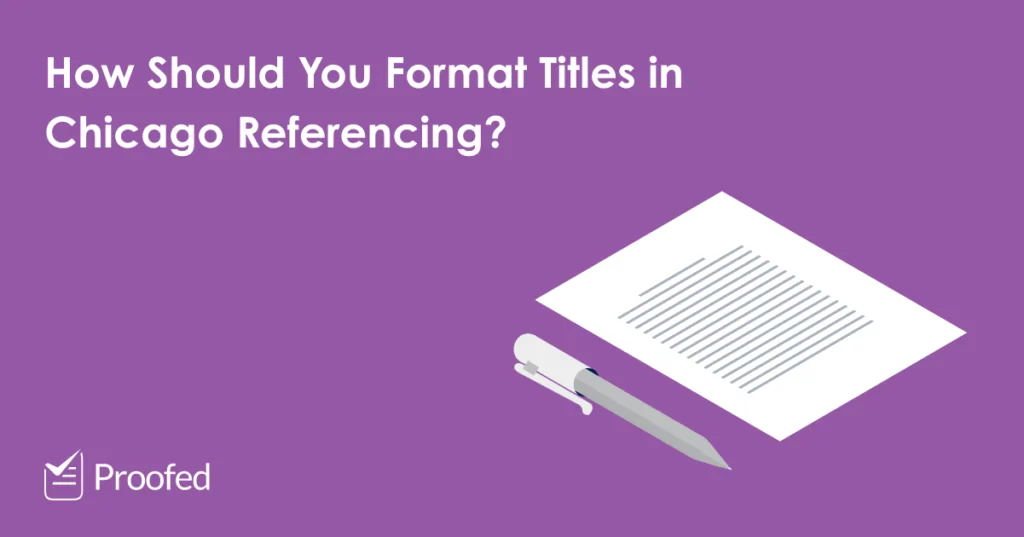If you’re using the Chicago Manual of Style, or even just the referencing styles it sets out, you’ll need to know how to write the titles of other works (e.g., books, articles, web pages). And to help you with this, we’re looking at how to write source titles in Chicago referencing.
How to Capitalize Source Titles in Chicago Style
In Chicago referencing, when you mention a source or publication in the main text of your work or in the references, it should use headline-style capitalization. Also known as title case, this involves capitalizing:
- The first word in the title and (if relevant) subtitle.
- Any nouns, verbs, pronouns, adverbs, and adjectives.
- Any conjunctions other than “and,” “but,” “for,” “or” and “nor.”
You can see examples of titles capitalized like this below:
David Olusoga is known for books such as Black and British: A Forgotten History and The Kaiser’s Holocaust: Germany’s Forgotten Genocide and the Colonial Roots of Nazism. But he has also produced several television programs, including The Unwanted: The Secret Windrush Files and A House Through Time.
The Chicago Manual of Style notes that some editors prefer to use sentence-style capitalization. As such, if you’re writing for a publisher or journal, you may want to check which style to use. Usually, though, “Chicago style” means using title case and capitalizing titles as shown above.
Italics or Quote Marks?
In the examples above, we’ve italicized all the source titles. You should do this in Chicago style for all full-length sources (i.e., sources published as standalone works), including:
- Books, periodicals (e.g., journals, newspapers), and blogs.
- Poems, plays, and pamphlets published as standalone works.
- Films, televisions shows, radio series, video games, and podcasts.
- Standalone musical works (e.g., operas, pop albums).
- Paintings, statues, and other works of art.
However, Chicago places titles of shorter works in quote marks, including:
- Articles from periodicals and chapters from books.
- Single poems or plays from a collection.
- Episodes from a television, radio, or podcast series.
- Songs and other short recordings.
- Blog posts or single pages from websites.
There are even a few cases where you should write titles with no italics or quote marks. The most notable of these exceptions are websites (e.g., Vox, Project Gutenberg), instrumental music (e.g., Bach’s Mass in B Minor) and classic works of art where the creator is unknown (e.g., the Venus de Milo).
Non-English Titles in Chicago Referencing
The rules above change slightly for works in languages other than English. The biggest difference here is that Chicago suggests writing non-English titles using sentence-style capitalization:
Find this useful?
Subscribe to our newsletter and get writing tips from our editors straight to your inbox.
Paul Ricoeur’s first published work was Gabriel Marcel et Karl Jaspers: Philosophie du mystère et philosophie du paradoxe (1947).
Here, we only capitalize the proper nouns (Gabriel Marcel, Karl Jaspers) and first word of the subtitle (Philosophie) since the title is in French.
And the rules get even more confusing when you include an English translation of a non-English title in your work! In these cases, you should:
- Use sentence case and Roman type (i.e., no italics or quote marks) for translated titles when the work has never been published in English.
- Use title case and italics (standalone works) or quote marks (shorter works) for titles if the work has been published in translation.
You can see the difference between these below:
Paul Ricoeur’s first published work was Gabriel Marcel et Karl Jaspers: Philosophie du mystère et philosophie du paradoxe (Gabriel Marcel and Karl Jaspers: Philosophy of mystery and philosophy of paradox). Arguably his last major work, meanwhile, was Vivant jusqu’à la mort (Living Up to Death, published in translation in 2009).
Here, the first source mentioned has not been published as an English translation. As such, we show this by giving the English title in sentence case without italics. But the second work has been published in translation in English, so we give the translated title in title case and italics.
Expert Chicago Proofreading
If you’re using Chicago referencing in an essay (or the Chicago Manual of Style in general) and need to be sure your document is clear and correct, we have expert editors and proofreaders ready to help.
Upload a trial document for free today to find out more.



